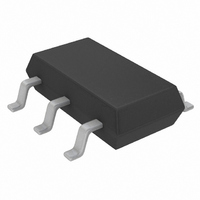LTC1734ES6-4.1#TRM Linear Technology, LTC1734ES6-4.1#TRM Datasheet - Page 6

LTC1734ES6-4.1#TRM
Manufacturer Part Number
LTC1734ES6-4.1#TRM
Description
IC BATT CHRGR LI-ION LIN SOT23-6
Manufacturer
Linear Technology
Datasheet
1.LTC1734ES6-4.2TRMPBF.pdf
(12 pages)
Specifications of LTC1734ES6-4.1#TRM
Function
Charge Management
Battery Type
Li-Ion, NiCd, NiMH
Voltage - Supply
4.55 V ~ 8 V
Operating Temperature
-40°C ~ 85°C
Mounting Type
Surface Mount
Package / Case
SOT-23-6 Thin, TSOT-23-6
Lead Free Status / RoHS Status
Contains lead / RoHS non-compliant
Other names
LTC1734ES6-4.1
LTC1734ES6-4.1
LTC1734ES6-4.1
Available stocks
Company
Part Number
Manufacturer
Quantity
Price
OPERATIO
APPLICATIO S I FOR ATIO
LTC1734
The LTC1734 is a linear battery charger controller. Opera-
tion can best be understood by referring to the Block
Diagram. Charging begins when V
UVLO (Undervoltage Lockout) threshold V
external current programming resistor is connected be-
tween the PROG pin and ground. When charging, the
collector of the external PNP provides the charge current.
The PNP’s emitter current flows through the I
and through the internal 0.06
This current is close in magnitude, but slightly more than
the collector current since it includes the base current.
Amplifier A3, along with the P-channel FET, will force the
same voltage that appears across the 0.06 resistor to
appear across the internal 60 resistor. The scale factor
of 1000:1 in resistor values will cause the FET’s drain
current to be 1/1000 of the charge current and it is this
current that flows through the PROG pin. In the constant
current mode, amplifier A2 is used to limit the charge
current to the maximum that is programmed by R
The PROG pin current, which is 1/1000 of the charge
current, develops a voltage across the program resistor.
When this voltage reaches 1.5V, amplifier A2 begins
diverting current away from the output driver, thus limit-
ing the charge current. This is the constant current mode.
The constant charge current is 1000 • (1.5V/R
As the battery accepts charge, its voltage rises. When it
reaches the preset float voltage of 4.2V (LTC1734-4.2
version), a precisely divided down version of this voltage
(2.5V) is compared to the 2.5V internal reference voltage
by amplifier A1. If the battery voltage attempts to exceed
Charging Operation
Charging begins when an input voltage is present that
exceeds the undervoltage lockout threshold (V
Li-Ion battery is connected to the charger output and a
program resistor is connected from the PROG pin to
ground. During the first portion of the charge cycle, when
the battery voltage is below the preset float voltage, the
charger is in the constant current mode. As the battery
voltage rises and reaches the preset float voltage, the
6
U
U
U
current sense resistor.
W
CC
rises above the
UVLOI
U
PROG
SENSE
UVLOI
and an
PROG
).
), a
pin
.
charge current begins to decrease and the constant
voltage portion of the charge cycle begins. The charge
current will continue to decrease exponentially as the
battery approaches a fully charged condition.
Should the battery be removed during charging, a fast
built-in protection circuit will prevent the BAT pin from ris-
ing above 5V, allowing the precision constant voltage
circuit time to respond.
4.2V (2.5V at amplifier A1’s input) the amplifier will divert
current away from the output driver thus limiting charge
current to that which will maintain 4.2V on the battery. This
is the constant voltage mode.
When in the constant voltage mode, the 1000:1 current
ratio is still valid and the voltage on the PROG pin will
indicate the charge current as a proportion of the maxi-
mum current set by the current programming resistor.
The battery charge current is 1000 • (V
This feature allows a microcontroller with an ADC to easily
monitor charge current and if desired, manually shut down
the charger at the appropriate time.
When V
down by floating the otherwise grounded end of R
An internal 3 A current source pulls the PROG pin above
the 2.15V threshold of voltage comparator C1 initiating
shutdown.
For charging NiMH or NiCd batteries, the LTC1734 can
function as a constant current source by grounding the
BAT pin. This will prevent amplifier A1 from trying to limit
charging current and only A2 will control the current.
Fault conditions such as overheating of the die or exces-
sive DRIVE pin current are monitored and limited.
When input power is removed or manual shutdown is
entered, the charger will drain only tiny leakage currents
from the battery, thus maximizing battery standby time.
With V
the battery by the charger. In manual shutdown the base
is connected to V
CC
CC
removed the external PNP’s base is connected to
is applied, the charger can be manually shut
CC
by the charger.
PROG
/R
PROG
) amps.
PROG
.














